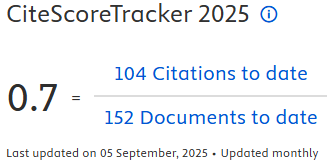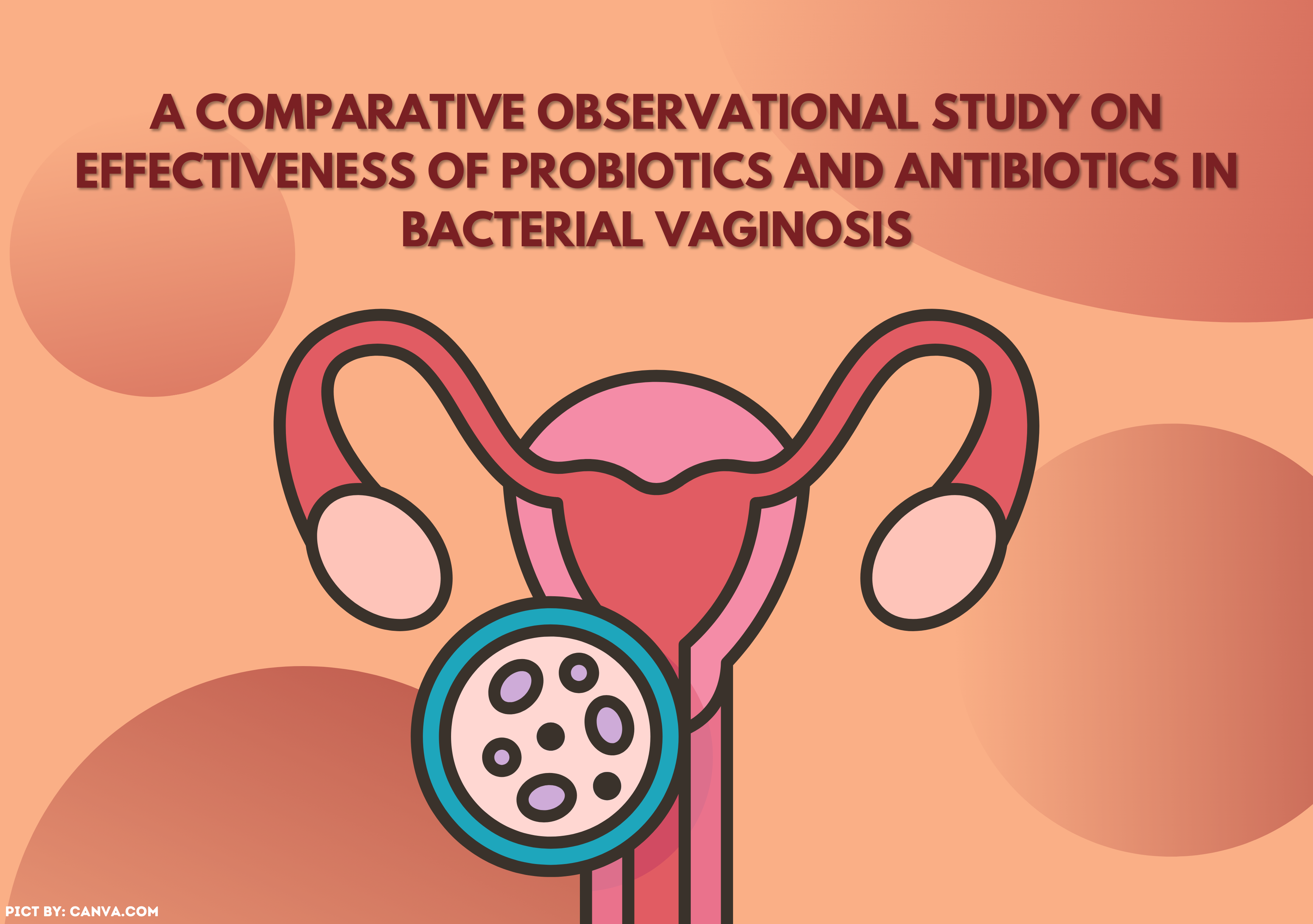VULVA HYGIENE BEHAVIOR DETERMINED BY HEALTH LITERACY AMONG ADOLESCENT GIRLS

Downloads
Introduction: Teens as young as 15-24 are vulnerable to reproductive system infections due to poor teenage vulva hygiene, exacerbated by a lack of understanding of the vulva's functioning. According to estimates, teenagers worldwide report reproductive channel infections. Previous research revealed that 46% of teenagers had poor reading skills. Aim: The goal of this study is to assess the association between healthy habits and vulva cleanliness in teenage girls. Methods: The study employs quantitative approaches, with 289 responses from high school students obtained by proportionally organized random sample processes. The HLS-EU-16Q Indonesian instruments and the vulva hygiene behavior scale have been approved as reliable. Results: This study discovered a significant relationship between health literacy and vulva hygiene practices (p-value= 0.05). Furthermore, 46% of the subjects have adequate health literacy, whereas 58.8% practice intermediate vulva hygiene activities. Conclusion: Proper health literacy can impact how teenage girls clean up their vulva. Researchers propose that young women can improve their vulva hygiene by seeking information, undergoing therapy, and consulting with health care providers.
Apfel, F., & Tsouros, A. D. (2013). Health literacy: the solid facts. Copenhagen: World Health Organization, 3–26.
Arifah, I., & Sharfina, M. F. (2019). Hambatan Akses Informasi Kesehatan Reproduksi Pada Mahasiswa Kesehatan Universitas Muhammadiyah Surakarta. Jurnal Kesehatan, 11(2), 65–74.
Berens, E.-M., Vogt, D., Messer, M., Hurrelmann, K., & Schaeffer, D. (2016). Health literacy among different age groups in Germany: results of a cross-sectional survey. BMC Public Health, 16(1), 1–8. https://doi.org/10.1186/s12889-016-3810-6
Berkman, N. D., Sheridan, S. L., Donahue, K. E., Halpern, D. J., & Crotty, K. (2011). Low health literacy and health outcomes: an updated systematic review. Annals of Internal Medicine, 155(2), 97–107. https://doi.org/https://doi.org/10.7326/0003-4819-155-2-201107190-00005
Berliana, P. R. (2018). Hubungan perilaku vulva hygiene dengan kejadian keputihan di SMP 2 Mejobo Kudus. Prosiding HEFA (Health Events for All).
Bitew, A., Abebaw, Y., Bekele, D., & Mihret, A. (2017). Prevalence of bacterial vaginosis and associated risk factors among women complaining of genital tract infection. International Journal of Microbiology, 2017. https://doi.org/https://doi.org/10.1155/2017/4919404
Board, T. N. P. and F. P. (2017). Demographic and Survey Adolescents Reproductive Health 2017. BKKBN.
Budhathoki, S. S., Pokharel, P. K., Jha, N., Moselen, E., Dixon, R., Bhattachan, M., & Osborne, R. H. (2019). Health literacy of future healthcare professionals: a cross-sectional study among health sciences students in Nepal. International Health, 11(1), 15–23. https://doi.org/https://doi.org/10.1093/inthealth/ihy090
Budiono, M. A., & Sulistyowati, M. (2013). Peran UKS (usaha kesehatan sekolah) dalam penyampaian informasi kesehatan reproduksi terhadap siswa SMP Negeri X di Surabaya. Jurnal Promkes, 1(2), 184–191.
Butar-Butar, M. H. (2016). Hubungan Pengetahuan dan Sikap Dengan Tindakan Remaja Putri Tentang Personal Hygiene Saat Menstruasi di SMA Negeri I Sitinjak Kecamatan Angkola Barat Tahun 2016. Jurnal Kesehatan Masyarakat Dan Lingkungan Hidup, 1(1), 69–78.
Darma, M., Yusran, S., & Fachlevy, A. F. (2017). Hubungan Pengetahuan, Vulva Hygiene, Stres, Dan Pola Makan Dengan Kejadian Infeksi Flour Albus (Keputihan) Pada Remaja Siswi Sma Negeri 6 Kendari 2017. Haluoleo University. https://doi.org/10.37887/jimkesmas.v2i6.2916
Garcia-Codina, O., Juvinyà-Canal, D., Amil-Bujan, P., Bertran-Noguer, C., González-Mestre, M. A., Masachs-Fatjo, E., Santaeugènia, S. J., Magrinyà-Rull, P., & Saltó-Cerezuela, E. (2019). Determinants of health literacy in the general population: results of the Catalan health survey. BMC Public Health, 19, 1–12. https://doi.org/https://doi.org/10.1186/s12889-019-7381-1
Hamed, A. G. (2015). The impact of genital hygiene practices on the occurrence of vaginal infection and the development of a nursing fact sheet as prevention massage for vulnerable women. IOSR-JNHS, 4(6), 55–64.
Hubaedah, A. (2020). Relationship Between Knowledge And Behavior Of Vulva Hygiene When Menstruate With The Event Of Pruritus Vulvae In Adolescents. Wiraraja Medika : Jurnal Kesehatan, 10(1), 1–9. https://doi.org/10.24929/fik.v10i1.932
Humairoh, F., Musthofa, S. B., & Widagdo, L. (2018). Faktor-faktor yang mempengaruhi perilaku vulva hygiene pada remaja putri panti asuhan di kecamatan tembalang, kota semarang. Jurnal Kesehatan Masyarakat (Undip), 6(1), 745–752. https://doi.org/https://doi.org/10.14710/jkm.v6i1.20310
Keatman, T., Cavill, S., & Mahon, T. (2018). Menstrual Hygiene Management in Schools in South Asia, Synthesis Report. Water Aid.
Khairunnisa, H. (2017). Self esteem, self awareness dan perilaku asertif pada remaja. University of Muhammadiyah Malang.
Kim, S. H., & Lee, A. (2016). Health‐literacy‐sensitive diabetes self‐management interventions: a systematic review and meta‐analysis. Worldviews on Evidence‐Based Nursing, 13(4), 324–333. https://doi.org/https://doi.org/10.1111/wvn.12157
Kustin, K. (2022). Kesehatan Reproduksi Pada Remaja Putri SMPN 8 Jember. Jurnal Dr. SOEBANDI.
Manganello, J. A. (2008). Health literacy and adolescents: a framework and agenda for future research. Health Education Research, 23(5), 840–847.https://doi.org/10.1093/her/cym069
Notoatmodjo, S. (2010). Ilmu Perilaku Kesehatan, Penerbit Rineka Cipta. Jakarta.
Nurjanah, N., & Rachmani, E. (2014). Demography and Social Determinants of Health Literacy in Semarang City Indonesia. International Conference on Health Literacy and Health Promotion, 1–8.
Nurjanah, N., Soenaryati, S., & Rachmani, E. (2016). Health literacy pada mahasiswa kesehatan, sebuah indikator kompetensi kesehatan yang penting. VISIKES: Jurnal Kesehatan Masyarakat, 15(2).
Nurulicha, S. P. D. K. W. (2019). Perbedaan Pengetahuan, Sikap, Sumber Informasi Dan Faktor Lainnya Pada Personal Hygiene Saat Menstruasi. Jurnal Kesehatan Dan Kebidanan (Journal Of Health And Midwifery), 8(1), 1–13.
Nutbeam, D. (2015). Defining, measuring and improving health literacy. Health Evaluation and Promotion, 42(4), 450–456. https://doi.org/10.7143/jhep.42.450
Organization, W. H. (2016). Global health sector strategy on sexually transmitted infections 2016-2021: toward ending STIs. World Health Organization.
Organization, W. H. (2017). Shanghai declaration on promoting health in the 2030 Agenda for Sustainable Development. World Health Organization.
Purnamasari, I. A., & Hidayanti, A. N. (2019). Factors Associated With The Incidence of Vaginal Discharge in Women of Childbearing Age in Banjarejo Sub District, Madiun City. The Shine Cahaya Dunia S-1 Keperawatan, 4(1).
Rosdiana, S. S., & Satriyandari, Y. (2014). Pengaruh Penyuluhan Kesehatan Reproduksi Remaja terhadap Pengetahuan Memelihara Organ Genetalia pada Siswi SMP Muhammadiyah Imogiri Bantul tahun 2014. STIKES’Aisyiyah Yogyakarta.
Sabil, F. A., & Anisa, N. R. (2021). Sabil, F. A., & Rezki Anisa, N. (2021). The Relationship between Health Literacy and Self Care Management at Puskesmas Tamalanrea Makassar City. 10(2), 200–205. https://doi.org/https:// doi.org/10.12345/ jikp.v10i1.288
Senja, A. O., Widiastuti, Y. P., & Istioningsih, I. (2020). Adolescents’ Knowledge Level about Reproductive Health. Jurnal Keperawatan, 12(1), 85–92.
Sheridan, S. L., Halpern, D. J., Viera, A. J., Berkman, N. D., Donahue, K. E., & Crotty, K. (2011). Interventions for individuals with low health literacy: A systematic review. Journal of Health Communication, 16(SUPPL. 3), 30–54. https://doi.org/10.1080/10810730.2011.604391
Shi, D., Li, J., Wang, Y., Wang, S., Liu, K., Shi, R., Zhang, Q., & Chen, X. (2017). Association between health literacy and hypertension management in a Chinese community: a retrospective cohort study. Internal and Emergency Medicine, 12, 765–776. https://doi.org/https://doi.org/10.1007/s11739-017-1651-7
Sørensen, K., Van den Broucke, S., Fullam, J., Doyle, G., Pelikan, J., Slonska, Z., Brand, H., & European, (HLS-EU) Consortium Health Literacy Project. (2012). Health literacy and public health: a systematic review and integration of definitions and models. BMC Public Health, 12, 1–13. https://doi.org/https://doi.org/10.1186/1471-2458-12-80
Srigede, L., Zaetun, S., & Kristinawati, E. (2019). Efektifitas Perilaku Hidup Sehat dan Bersih Pada Kelompok Masyarakat Berisiko Dalam Pencegahan Infeksi Saluran Kemih. Media Bina Ilmiah, 13(10), 1665–1672.
Statistics., C. B. of. (2019). Statistics Indonesia (Subdirectorate of Statistical Publication and Compilation). Badan Pusat Statistik. Jakarta: Badan Pusat Statistik.
Suhasini, K., & Chandra, M. (2017). Factors influencing menstrual hygiene practice among late adolescent girls in an Urban area of Belgaum. Annals of Community Health, 4(4), 20–24.
Suka, M., Odajima, T., Okamoto, M., Sumitani, M., Igarashi, A., Ishikawa, H., Kusama, M., Yamamoto, M., Nakayama, T., & Sugimori, H. (2015). Relationship between health literacy, health information access, health behavior, and health status in Japanese people. Patient Education and Counseling, 98(5), 660–668. https://doi.org/https://doi.org/10.1016/j.pec.2015.02.013
Surmiasih, S., Noven, W., & Wahidun, W. (2019). Pendidikan kesehatan terhadap kemampuan remaja puteri dalam perawatan organ reproduksi. Holistik: Jurnal Kesehatan, 13(1), 76–83. https://doi.org/https://doi.org/10.33024/hjk.v13i1.1045
Syecha, P. N. (2016). Hubungan Akses Informasi Kesehatan Dengan Health Literacy Mahasiswa Universitas Dian Nuswantoro Semarang. Skripsi, Fakultas Kesehatan.
Wahyuningsih, T. (2019). Faktor-Faktor Yang Mempengaruhi Literasi Kesehatan Masyarakat di Puskesmas Banguntapan I Bantul DIY. Jurnal Manajemen Informasi Dan Administrasi Kesehatan, 2(1). https://doi.org/https://doi.org/10.32585/jmiak.v2i01.447
Wang, W., Hou, Y., Hu, N., Zhang, D., Tao, J., Man, Y., Wang, A., Li, L., & Bi, Y. (2014). A cross-sectional study on health-related knowledge and its predictors among Chinese vocational college students. BMJ Open, 4(10). https://doi.org/10.1136/bmjopen-2014-005182
Wihdaturrahmah, & Chuemchit, M. (2023). Determinants of Menstrual Hygiene Among Adolescent School Girls in Indonesia. International Journal of Women’s Health, 943–954. https://doi.org/https://doi.org/10.2147/IJWH.S400224
Yani, S. F., Indriarini, M. Y., & Barus, L. S. (2022). Gambaran Self Awareness Tentang Tindakan Vulva Hygiene Pada Wanita Dewasa Dalam Mencegah Infeksi Saluran Kemih. Jurnal Kesehatan, 10(2), 50–67.
Yuliawati, S., Suganda, D., & Darmayanti, N. (2021). Peningkatan Literasi Kesehatan Di Tengah Pandemi Covid-19 Bagi Guru-Guru SDN Di Kota Sukabumi. Kumawula: Jurnal Pengabdian Kepada Masyarakat, 4(3), 458–464. https://doi.org/https://doi.org/10.24198/kumawula.v4i3.35467
Yusuf, R. N. (2021). Kesehatan Reproduksi Sepanjang Daur Hidup Wanita. OSF Preprints. June, 28.
Zhang, Y., Zhang, F., Hu, P., Huang, W., Lu, L., Bai, R., Sharma, M., & Zhao, Y. (2016). Exploring health literacy in medical university students of Chongqing, China: a cross-sectional study. PloS One, 11(4), e0152547. https://doi.org/https://doi.org/10.1371/journal.pone.0152547
Zulfuziastuti, N., & Satriyandari, Y. (2017). Pengaruh Pendidikan Kesehatan Reproduksi Terhadap Sikap Personal Hygiene Remaja Putri Saat Menstruasi Di SMPN 2 Gamping. Universitas’ Aisyiyah Yogyakarta.
Copyright (c) 2025 The Indonesian Journal of Public Health

This work is licensed under a Creative Commons Attribution-NonCommercial-ShareAlike 4.0 International License.
- The authors agree to transfer the transfer copyright of the article to The Indonesian Journal of Public Health effective if and when the paper is accepted for publication.
- Authors and other parties are bound to the Creative Commons Attribution-NonCommercial-ShareAlike 4.0 International License for the published articles, legal formal aspect of journal publication accessibility refers to Creative Commons Attribution-NonCommercial-ShareAlike 4.0 International License (CC BY-NC-SA), implies that:
- Attribution ” You must give appropriate credit, provide a link to the license, and indicate if changes were made. You may do so in any reasonable manner, but not in any way that suggests the licensor endorses you or your use.
- NonCommercial ” You may not use the material for commercial purposes.
- ShareAlike ” If you remix, transform, or build upon the material, you must distribute your contributions under the same license as the original.































